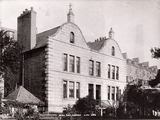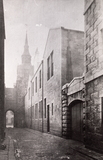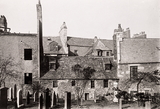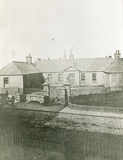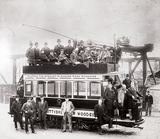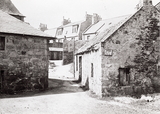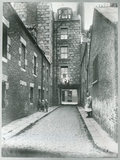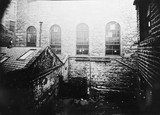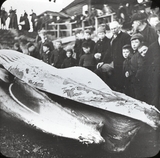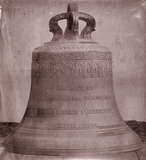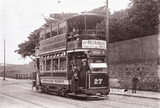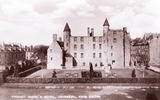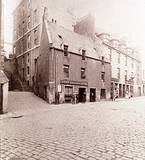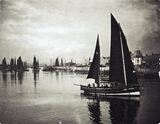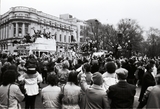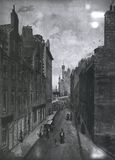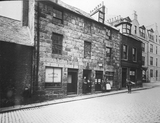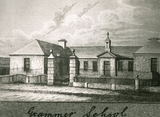|
Quick Search
|
Search Results
You searched for: More Like: 'Back Wynd'
268 items
items as
Schoolhill
13 Old houses skirting St. Nicholas churchyard once formed part of the south side of Schoolhill. They were demolished in 1884-85 as part of a street widening scheme and the present wall and railing stand in their place. On the other side of Schoolhill (centre) can be seen the roof and turrets of George Jamesone's House, demolished in 1886.
The book Aberdeen in Byegone Days: Views of Streets and Buildings, etc. with Letterpress Description (1910) by Robert Anderson (page 26) suggests that the building in the centre of this image was the home of Burnett Carr, the grave-digger and assistant to the sexton of St. Nicholas Church.
Newspaper references indicate that Carr, a well known figure, died on 31st May 1844 (Aberdeen Journal, 5th June 1844, page 3, column 2).
This photograph looks north and shows the back of Carr's old house. Mackie Place
33 4-5 Mackie Place, Aberdeen, c.1870. The street was named after Robert Mackie, a skinner who was Convener of the Incorporated Trades.
At No.6 there was a haunted house known as the 'The Castle'. The Denburn flows past the back of the building. When first built, the address was 'The Galleries'. Lodge Walk
50 Lodge Walk which ran from Castle Street to Queen Street dates back to 1754 when the Aberdeen Lodge moved into Chambers at the New Inn. The jail for Aberdeen was at one time the Tolbooth, the spire of which can be seen at the centre of the photograph. Old Aberdeen
71 A reproduced engraving showing the skyline of Old Aberdeen. The image looks north from around the lands of Sunnyside Farm.
In the foreground can be seen two agricultural labourers. On the skyline, going left to right, is the circular Powis Hermitage, on a hill, with its small spire, the twin spires of St. Machar Cathedral in the far distance, the tower of the Old Town House at the end of the High Street, which is protruding above the southern elevation of St. Mary's United Free Church.
Moving back along the High Street, the south facing front elevation, with bow windows, of Powis Lodge can be seen above the line of trees. The crown tower of King's College is across the street. The two minarets of the Powis Gateway are just next to it. Further along are the crenelations of Cromwell's Tower.
The tower on the far left of the image may be Dunbar's Tower.
The minaret gateway was finished in 1834 and this image likely dates from around that period. Schoolhill from St. Nicholas Churchyard
120 This photograph taken in 1880 from St. Nicholas Churchyard looks north showing a row of houses which stood between it and Schoolhill.
These houses were demolished around 1884 as part of an improvement scheme to widen Schoolhill - named after the old Grammar School which stood nearby.
A dwarf wall with ornamental railings was erected in place of these buildings and a porter's lodge was removed from Robert Gordon's College to form a lodge for the sexton at the entrance to the churchyard.
The book Aberdeen in Byegone Days: Views of Streets and Buildings, etc. with Letterpress Description (1910) by Robert Anderson (page 26) suggests that the building in the centre of this image was the home of Burnett Carr, the grave-digger and assistant to the sexton of St. Nicholas Church.
Newspaper references indicate that Carr, a well known figure, died on 31st May 1844 (Aberdeen Journal, 5th June 1844, page 3, column 2).
This photograph looks north and shows the back of Carr's old house. Old Grammar School
125 This rather plain building which stood in Schoolhill was the old Grammar School. It was closed as a school in 1863, when the new school in Skene Street was opened. The building was demolished c.1882/3. The Grammar School seems to date back to the 13th century with successive buildings on this site. Pupils were taught Latin, Greek and English grammar with the aim of preparing them for entry to university. One of the most famous pupils here was Lord Byron, who attended from the age of 7 in 1795 for 4 years. The site was later occupied partly by The Robert Gordon University buildings. Woodside electric tram
137 The inaugural procession on 23rd December 1899 for the electrification of the Woodside tram route, the first in Aberdeen to be modernised.
Lord Provost John Fleming is at the helm, with Tramways Convener Alexander Wilkie standing next to him, and Councillor Alexander Glass has his foot on the platform.
Next to Fleming and Wilkie, and above Glass, appears to be Alexander Lyon, provost between 1905-1908. Baillie James Taggart, also later to be provost, is the right-most figure in the back row on the roof of the car. Two to the left of Taggart may be James Walker, provost between 1903-1905.
James Alexander Bell, City Electrical Engineer for Aberdeen in the late 19th and early 20th centuries, is the bowler hatted figure on the stairs above Lord Provost Fleming.
This inauguration is detailed in an article titled 'Electric tramways in Aberdeen: Opening of Woodside section' in the Aberdeen Journal of 25th December 1899, page 7. It details the celebratory tram trip shown here and a luncheon in the Town and County Hall that followed. Old Deeside Road
147 Local historian A.G. Duthie has been in touch to identify this image as the most easterly point of the Old Deeside Road.
The photograph is taken from the position of the modern day junction of Great Southern Road and Holburn Street. The house in the background is still visible today.
In his book The Old Deeside Road, G.M. Fraser writes, "The commencement of the old road at Hardgate is still, fortunately, to be seen, near Fonthill Road, at the group of ruinous houses connected with what was long known as Palmer's Brewery. The 'lie' of the old houses at the back of the brewery shows the run of the old road, two of the small, dilapidated buildings being clearly the eastmost houses of the old road just where it touched the Hardgate." (p. 19)
This scene was photographed for Aberdeen Public Library on 6th July 1917 by Mr. James Ritchie. Shuttle Lane prior to slum clearance
193 This 1930s photograph shows the Shuttle Lane slum clearance area situated between East North Street and Frederick Street, before the families were rehoused on new estates.
These houses were typical of the cramped, overcrowded tenements to be found in most Scottish cities. Large families would be crammed into 1 or 2 rooms. There might have been a shared toilet on the landings or more commonly outside in the back yard.
Infectious diseases such as diptheria and scarlet fever could be spread rapidly with such close contact of families, and infant mortality was high. There was often no drying green so many tenements had iron washing poles which could be slid out of windows when needed. Each family would have their allocated day to use the wash house.
Washing clothes was a laborious affair as the mother, maybe with the assistance of an older daughter, would stoke and light the boiler, and trek back and forth with water from an outside tap. Washing would be done by hand and if the weather was bad, then it would have to be hung inside in the kitchen to dry in the heat of the coal fire.
However, it seemed that community spirit was warm and close neighbours helped each other in times of crisis. This was a bond that would be broken when families were rehoused in the modern housing estates. Gaelic Chapel, Belmont Street
322 The Gaelic Chapel was founded in the 18th century in response to the increasing numbers of Highlanders who came to the city in search of work.
At first, they held services in the East Church of St. Nicholas but, in the 1790s, they obtained ground in the area between Belmont Street and Back Wynd, now known as Gaelic Lane.
The opening services in the new church were conducted on 30th August 1795. In 1843, at the Disruption, the whole congregation followed their minister, Rev. Hugh Mackenzie, into the Free Church.
By 1882, the church had become old and dilapidated and needed so much renovation that the congregation decided to move. The property was disposed of and was used as a printing office by G. & W. Fraser for a number of years.
The congregation moved to a church on Dee Street which had become vacant on the disbanding of the United Free Methodists and it was named St. Columba United Free Church.
In 1907, they amalgamated with the High United Free Church and moved to their church at the junction of Belmont Street and Schoolhill.
Comparing the scene shown here and large scale historic maps suggests that this is likely a view of the rear of the Gaelic Chapel buildings, looking north, potentially taken from the back of a building on Union Street. Humpback whale on display, Aberdeen, 1884
336 The carcase of a whale stranded in the estuary of the Tay was taken to Aberdeen to be exhibited in an enclosure on the Inches near the Goods Station. The arrival of this monster came to the attention of John Struther, Chair of Anatomy at Aberdeen University, who took the whale back to Marschal College to skin and eventually put together an articulated skeleton which now reposes in Dundee Museum. Flourmill Brae
354 This image shows at the left hand side, a massive stone coffin which stood for many years at the back of tenements at Flourmill Brae. It was brought to the public's attention in 1926 when the area was subject to the Town Council's slum clearance scheme. The coffin consisted of granite slabs blackened and cracked through time. It was 5 and a half feet long, two feet wide and two feet deep. The sides and ends were held together by iron clamps and the lid was cemented on. The belief was that the coffin contained the remains of Mary Bannerman, one of the Bannermans of Elsick and married to George Leslie, Laird of Findrassie, near Elgin who died in 1692. However when the coffin was eventually opened it was empty apart from black earth. It was suggested that the slabs may have protected her coffin at some time and that the actual coffin and her remains had been removed to one of the city's graveyards.
Correspondent Ed Fowler has researched its location using historic maps and suggests that the stone sarcophagus was likely at the end of Quaker's Court near the Friends Meeting House, to the rear of the tenements looking onto Flourmill Brae. St. Nicholas Church bell
382 A photograph of one of the bells installed in St. Nicholas Church in 1887.
A carillon of 36 bells were ordered by Aberdeen Town Council from Severin van Aershodt of Louvain in Belgium to replaced those destroyed in the fire of 1874.
The bells were also commissioned and installed to commemorate Queen Victoria's Golden Jubilee, marking 50 years of her reign. The largest of the new bells was named Victoria.
On 11th May 1887, the new bells arrived at Aberdeen Goods Station, after being shipped to Leith, where they were loaded on to lorries, and paraded through the main streets of the city on their way to Back Wynd.
The inscription on the shown bell reads as follows:
"The gift of Councillor George Washington Wilson. Cast by Severin Vanaerschodt, Louvain Belguim." No. 27 Tram
392 Many thanks to Silver City Vault users Dr Mike Mitchell and Brian Kennedy for providing us with information on this photo. It shows the no. 27 tram on Victoria Road with the wall of Balnagask House in the background.
The Balnagask Mains farm is partially visible to the left of the tram. The St. Fittick's Road terminus of the Torry Route is located further along Victoria Road.
The female conductor indicates the photo was taken during the Great War. The tram waits to depart for Bridge Street. The Pleasure Park, Aberdeen Beach
397 A postcard showing John Henry Iles' Pleasure Park in the 1930s. The park's esplanade site, south of Wellington Street (roughly where Amadeus nightclub/the Range and part of the Queen's Links carpark would later stand), was leased to Iles by the Council in 1929. Illes was an amusement entrepreneur originally from Manchester.
The park's biggest attraction, in all senses, was the Scenic Railway roller coaster shown here. Iles was involved in several amusement parks around Britain and during a visit to New York he obtained the European rights to the design of the latest roller coasters. He subsequently erected his Scenic Railway in Aberdeen in 1929.
The roller coaster rose to 100 feet in the air at its highest point and was popular with holiday makers and locals throughout the 1930s. The local press recorded 21,000 children, between 3 and 14 years of age, carried on the ride during a special children's day that was held on Saturday 20th August 1932.
Part of the message written on the back of this postcard by a young visitor to Aberdeen reads "This picture shows you the scenic railway which I have been on and liked very much".
The Scenic Railway was sadly badly damaged by fire on the night of 5th December 1940 and was consequently demolished. Other attractions of Iles' park included rides such as The Caterpillar, The Whip, Water Dodgems, and the Brooklyn Racers (petrol driven cars).
In the background of this image be seen the tower of St. Clements Church and a row of tenements, likely those on Wellington Street. Provost Skene's House from the South
416 Provost Skene's House from the South. The earliest portion of the house dates back to 1545. The picture gallery c.1626 contains important religious paintings. The Green
424 The Green. The house occupied by John Buchan, baker, at the foot of the Back Wynd stairs leading up to Union Street was demolished in 1914. In the late seventeenth century the house was owned by George Aedie. Although Boots the Chemist have since relocated elsewhere, the stairs which replaced these are still often referred to as the Boots Stairs because there was an entrance to their premises on the left.
The golden teapot sign that belonged to John Adam's tea and coffee shop disappeared when the shop closed.
Correspondent Ed Fowler investigated the 1904 Post Office directory for Aberdeen to discover more information about the businesses visible in the image. John Adam's premises, with its golden teapot at 64 The Green, can be see on the far right. The tea merchant lived in Hammerfield House, 349 Great Western Road.
The next two entrances to the left, 66 and 68, are for the tenements above the shops. To the left of them at 70 The Green is a drapers called P. & C. Adams. The business also had premises at 47 George Street. Leaving Aberdeen Harbour
502 A Leith registered fifie leaving Aberdeen Harbour. The white building seen behind the sails is the Round House, the Harbour Master's office, on the New Quay at Fittie.
The fifie was a fast wind-powered sailing boat favoured for herring fishing on much of Scotland's east coast from the 1850s until well into the 20th century. Its main features were the vertical stem (front) and stern (back) and the wide beam (width) making them stable in the water.
Fifies had two masts, a main dipping lugsail and a mizzen sail. Fifie's were increasingly decked following the recommendations of Captain Washington's 1849 report into the Moray Firth fishing disaster.
See SCRAN's webpage on Scottish sail powered fishing boats for more information on the subject.
The Tidal Harbour is in the background, beyond the landing stage of Pocra Quay's Lower Basin. Back Wynd Stair, The Green
596 The Back Wynd stair is so named because, before the making of Union Street, the Back Wynd came right down from Schoolhill to The Green. The stairway was re-designed in the 1930s. European Cup Parade
652 Aberdeen Football Club's open top bus parade of the European Cup Winners' Cup in 1983. The photograph looks north west across Union Street towards its junction with Union Terrace.
Aberdeen defeated Real Madrid 2-1 in the final held in Gothenburg, Sweden on 11th May 1983.
The conquering heroes landed, cup in hand, at Aberdeen Airport at 14.40 the next day. The team received a rousing reception and were given a celebratory cake on arrival from an offshore catering company.
It was then on to the open top bus for the journey from Dyce to Pittodrie. Grampian Fire Brigade lined-up their engines outside their Anderson Drive headquarters as a unique guard of honour for the team as they headed for the city centre.
As shown here, the city streets were packed with fans of all ages, including some who had travelled back from Gothenburg.
Lord Provost Alex Collie, the Queen Mother and Margaret Thatcher all provided messages of congratulations. Celebrations ended at a teeming Pittodrie.
Aberdeen FC had another triumphant tour through the city centre only 10 days later after they beat Rangers 1-0 in the Scottish Cup Final at Hampden Park. The match was on the Saturday 21st May and the parade in Aberdeen was the next day. Exchequer Row
687 This view shows the narrow congested Exchequer Row, around 1900. It is a photograph of a watercolour painting by Alexander J. Murray that is in the collection of Aberdeen Archives, Gallery and Museums (AAGM).
The Balmoral style tower of the Salvation Army Citadel, opened in 1896, is seen in the distance with the Market Cross surrounded by an ongoing market.
Exchequer Row (first mentioned in 1350) was a short street connecting the Shiprow to the Castlegate, and on its right side, were a number of courts leading into an area crammed with insanitary dwellings which were later demolished.
It was popularly supposed that the name Exchequer Row derived from the Aberdeen Mint which stood in the area. However, it comes from the name of the Royal Customs House - the Skakkarium, dating back to the 14th century. 13 Skene Square
792 A photograph showing 13 Skene Square in the late 19th century. This tenement is thought to be the birthplace of the genre and portrait painter John Phillip (1817-1867).
The image is included as a plate in Historical Aberdeen: the Castle and the Castle-hill, the Snow Church, the Woolmanhill and neighbourhood, the Guestrow by G. M. Fraser (1905).
Fraser indicates that the tablet that can be seen above the door was put up in memory of John Phillip by his friend William Brodie (1815-1881), the sculptor.
Fraser elaborates as follows:
"The first plate on the house, 13 Skene Square, was placed there by William Brodie, the sculptor. that house was pulled down six years ago, but fortunately Mr George Watt, architect, the proprietor of the house erected on the spot, has, with much public spirit, placed a bronze tablet on the new house telling that Phillip's house stood on that site. I wish we could be absolutely certain that Phillip was born here. There can be no doubt that he lived here as a child, but it suggestive that in the detailed notices of Phillip in the Aberdeen papers at the time of his death, it was said that he was born in Windy Wynd, where his father was a shoemaker. See Aberdeen Journal, 6th March, 1867; Aberdeen Free Press, 1st March, 1867. Old Grammar School
795 This rather plain building which stood in Schoolhill and was demolished about 1882/3 was the old Grammar School. It was closed as a school in 1863 when the new school in Skene Street was opened. The Grammar School seems to date back to the 13th century with successive buildings on this site. Pupils were taught Latin, Greek and English grammar with the aim of preparing them for entry to university. One of the more famous pupils here was Lord Byron, who attended from the age of 7 in 1795 for 4 years. The site is now partly occupied by buildings occupied by The Robert Gordon University. |





